Special Birthday Release: The First Chapter of Khanyisa’s Children’s Book
Once Upon A Time
We are busy writing a children’s book about Khanyisa’s journey, to share her life with young readers and create new homes and classrooms of elephant lovers. We hope to finish all the chapters soon and start the process of looking for publishers who share our vision for the book. Here is a sneak peek at the very first chapter of the book, in celebration of Khanyisa’s fourth birthday this September.

1.
The night Khanyisa arrived at the orphanage, her new family were ready and waiting.
In the warmth of the nursery, standing in lookout mode indoors, was Lammie, a very special sheep, certainly no ordinary sheep. Lammie noticed what was happening around her. The humans were hurriedly preparing another nursery, laying down the hay to create a soft, warm bed. The lights were on in the kitchen as the orphanage carers readied the milk bottles and medical supplies. Phones rang as nature’s own calls sounded across the wilderness outside.
You see, this wasn’t an orphanage in a city or on a farm. This was deep in the South African bush, where wild animals roamed freely and protected in a private nature reserve. Lions were out hunting by the light of the moon. Leopards were on the prowl, slipping through the trees. And Lammie, she was waiting… Something was up and she was beginning to get that feeling. She had been through this before. The arrival of an orphan.
Khanyisa was discovered alone on 6 January 2020, in a nature reserve neighbouring the south-west of the Kruger National Park by two employees of the Mpumalanga Tourism and Parks Agency. She was trapped in a wire snare that poachers use to catch animals in the bush for food. Her herd was nowhere to be seen. The snare had wrapped around her neck, head and cheeks and as Khanyisa tried to free herself, the wire had pulled tighter. This created terrible cuts in her skin, as well as her ear, cutting off the top of the right ear with the sharp edges of the wire.
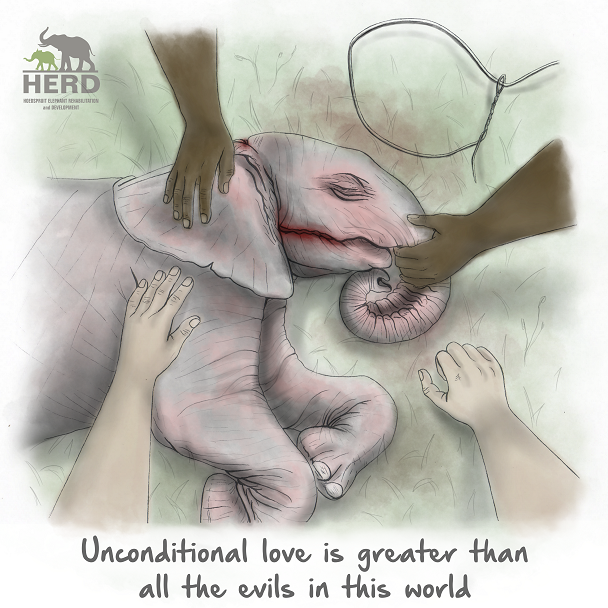
The team who happened upon the little albino elephant were amazed to find the calf alive, considering all she had endured. They quickly took to rescuing her, removing the snare and transferred her to the Care for Wild Rhino Sanctuary in Mpumalanga to be stabilised. In the meantime, an inter-provincial permit was arranged to translocate her to the province of Limpopo, where HERD (Hoedspruit Elephant Rehabilitation and Development) is situated.
The HERD team received a call from wildlife vet, Dr. Albertus Coetzee asking if they could receive the wounded orphan. Immediately HERD Founder, Adine Roode, the Operations team and Carers began preparing to fetch the calf and welcome her to the orphanage.
Within the hour, Juan, and elephant carers, Joshua, and Khensani left the orphanage for the three-hour drive to the Care for Wild facility. Adine arranged the necessary permits. Petronella of Care for Wild and her veterinary team attended to the calf’s wounds and gave her the essential care that she needed. That night, Joshua, Juan, and Khensani stayed to look after Khanyisa, until Adine arrived with wildlife vet Ben Muller who would assist with the transfer of the calf to the orphanage. The little one seemed in good spirits and by 19h00 the next day, they arrived at HERD.
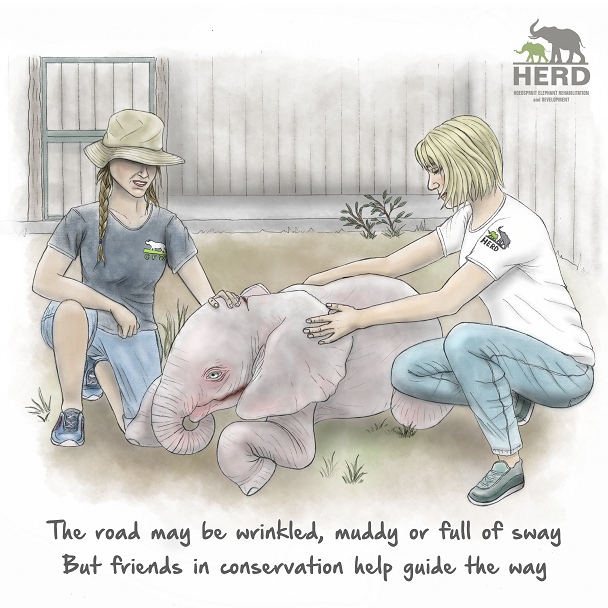
HERD is home to South Africa’s very first dedicated elephant orphanage, alongside which lives a herd of rescued and orphaned elephants between the ages of five and thirty six years of age. A blended family of their own that gives orphans a chance to join a herd once again, to live with their own species.
It was here at the orphanage that Lammie the companion sheep was waiting for the new arrival. The little sheep stood upright in her nursery, in lookout mode, her four slender legs holding up her rather curvaceous body and that unique tail. Typical of her breed, the Pedi Thaba Manzi sheep, Lammie had a large tail that you could easily mistake for an elephant’s trunk, with fat deposits that help her breed survive harsh droughts or arid climates.
The team at the orphanage were quite convinced that Lammie thought herself an elephant in fact, as this motherly little animal had been a nanny to many orphan elephants as well as orphan rhino calves during her short lifetime. Born in 2014, Lammie had been a companion to animals who had lost their families. Her motherly side was strong and she was hardy like the best of nannies, able to withstand the fussiest, most headstrong baby rhino, and the temper of traumatised young elephants.
Khanyisa arrived in the dark of night. Her pinkish albino skin amazed everyone. The team at the orphanage had not seen many albino calves in their lives and up close now, they could detect all the ways this special calf differed from other elephants her age. In the light of the orphanage, they could see her blonde tail hairs and eyelashes, her eyes that shone a bright blue, although they lacked any pigment whatsoever, and her pale peachy skin with its fuzzy covering of light hair. She was unlike anything they had expected and she would change their lives entirely over the course of her rehabilitation.
To help her settle in for her very first night in her new home, the head of the orphanage team, the Human Matriarch you could call her, or simply, Adine, took Khanyisa outside into the nursery garden. Adine sat down on the grass, making herself smaller so to be less threatening to the calf. She eventually lay down, under the starry sky that blanketed their view of the wilderness around them, and Khanyisa walked over to her, nudging her, investigating her. Adine let out a grrrrrr in an effort to mimic a soft elephant rumble and after a few tries, Khanyisa eventually returned it with her own gentle rumble.
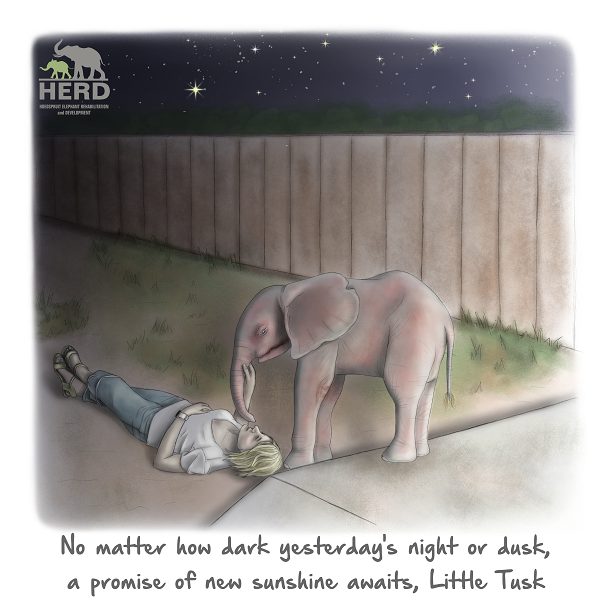
You couldn’t see them clearly with the human eye, but in the darkness, on the other side of the orphanage fence, was the herd. Tokwe, the elephant Matriarch, was standing at the gate, her trunk lifted up, no doubt to detect the sounds and smells coming from next door.
Tokwe’s large silhouette was visible in the light of the homestead – the greater elephant herd’s home camp. Tokwe and her herd stayed here overnight, from sunset to sunrise, with large gardens and an undercover area divided into four sections. Tokwe stayed in the quadrant closest to the orphanage, with her own daughters, Limpopo, the eldest elephant born to the herd, and Pisa, Limpopo’s younger sister. Also overnighting with the Matriarch were two orphan elephants now accepted into this unique family – Kumbura and Timisa, as well as a true survivor known as Fishan, a bull elephant who had survived and overcome a fractured leg. The other elephants were busily grinding away at bunches of an elephant favourite called bana grass – long, bright green grass that the human herd grew and harvested for the herd, to keep them well fed through the night. But Tokwe was joining Lammie on lookout. There was a new scent in the home camp and what it might be telling Tokwe we didn’t know, but there she stood, reading her surroundings like a book.
Elephant Carer, Solani Herman Khoza, known to all as Herman, was on night duty, joining Adine, Lammie and the little albino calf in the orphanage. Herman was a gentle, softly spoken man from the nearby town of Acornhoek. He used to work as a gardener at the lodge in HERD’s reserve, called Jabulani, in 2008. He was a valued and respected part of the Jabulani team and always went above and beyond. On one occasion he even saved a General Manager’s life from a lion. One of Herman’s responsibilities was to tend to the wormery. Adine noticed just how lovingly he handled every worm, a little creature that he treated with such respect and care.
Herman spent hours seeing to the wooden box that stood under the shade cloth of the aquaponics nursery behind the orphanage. He filled the box with new food waste and collected dung to include several times a week. He monitored the worms and the final product, and turned the compost over and over to prevent overheating. He was patient and dedicated. He learnt quickly how to manage the little wormery in the wild and never missed a day.
Adine saw something special in him and believed that he had the heart of an elephant carer. He had the qualities needed to raise a baby elephant orphan – the ability to love and care for one in need, beyond the call of duty. Adine asked Herman to consider training for this new position. Herman accepted it with open arms. Months later, Herman was ready to receive Khanyisa and to protect and support her as though she were his very own child.
Herman laid the hay down over the cement ground to create a soft bed for the little calf on her first night. He collected and delivered fresh bana grass into the corner of the nursery and tied branches felled from the bush to one side of the wooden poles that surrounded the nursery. He poured fresh water into the trough placed outside the wooden poles – within trunk’s reach from where Khanyisa would lay her head for the night.
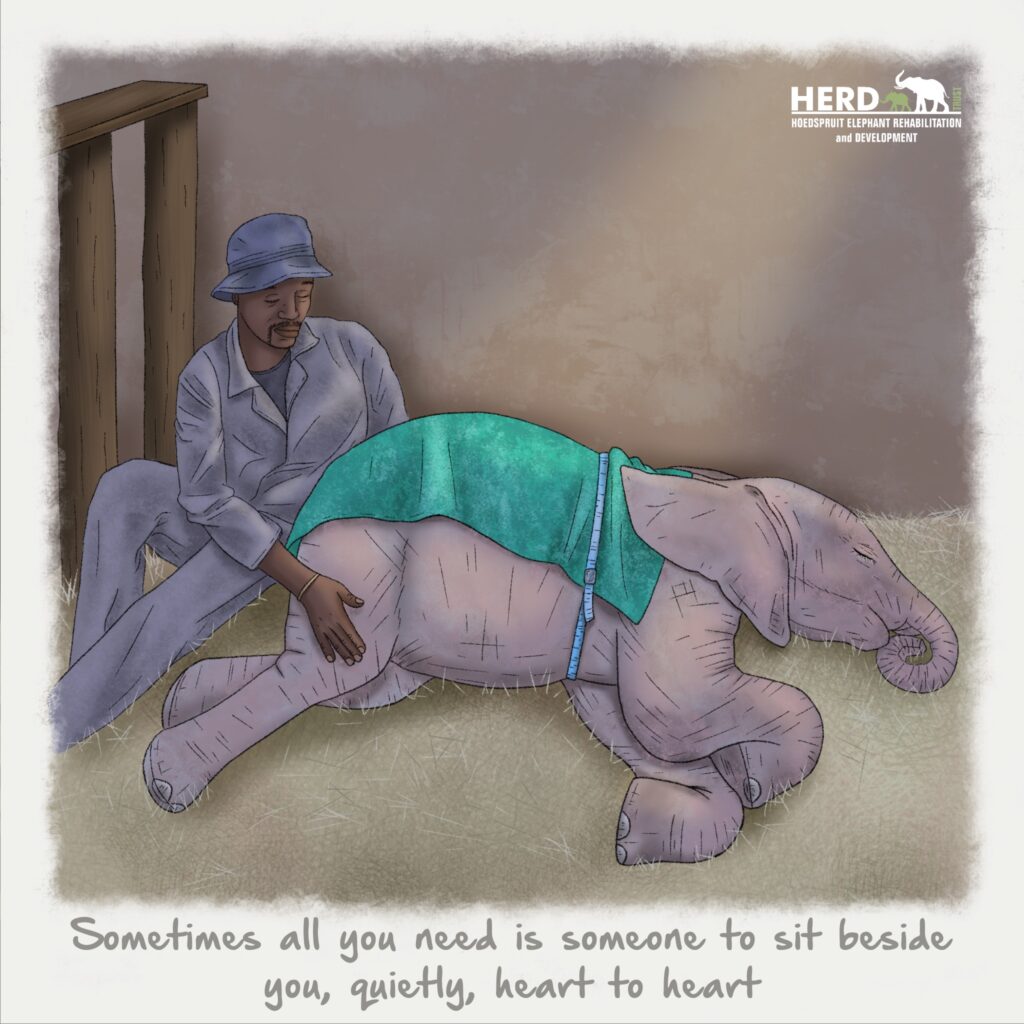
But first, the veterinary team and elephant care team needed to attend to the little one. Khanyisa had many emotional wounds to recover from, with the trauma she had endured. The calf was either abandoned by her elephant family before or after her accident, but it’s likely that the trap caught Khanyisa as she and her herd were walking through the bush, and that her family were not able to help free her. Elephants are family centred animals and stick together through thick and thin, but at times like this, they are helpless and have to move on, for the survival of the rest of their herd. However Khanyisa came to be orphaned, it was no doubt traumatic.
The first 24 to 48 hours are the most crucial in caring for a distressed elephant calf. It is essential that they are provided with the correct milk formula for their complex needs and provided with a lot of love and emotional support.
The open flesh of Khanyisa’s deep mouth wounds from the snare had maggots feeding off the flesh, creating gaping holes in her mouth. The care team had to treat the calf’s wounds to combat infection and keep them clean. Adine sat on the hay in front of Khanyisa as the elephant lay down on one side. With a headlamp shining out from her forehead, her spectacles neatly in place, Adine carefully swabbed the wounds with antiseptic. Carer Joshua held the tray alongside her, holding the apparatus needed for the task at hand. Together, through the evening, they gently, slowly, cleaned the incisions across Khanyisa’s neck and cheeks. Lammie was close by, deciphering the strange smells that now inhabited her nursery.
Herman prepared a milk bottle for Khanyisa in the kitchen alongside the nursery, blending together the infant milk formula, boiled water and other ingredients to provide energy and nutrients for the new patient. Herman poured the warm milk mixture into a plastic Coca Cola bottle and attached the teat to the top. He carried the bottle to Adine in the nursery, unlocking the gate to the enclosure and joining the team inside on the hay. Adine stood up beside the calf, who started to stir with the activity around her. Adine bent over as Khanyisa stood up, reaching her human carer’s knees, and aimed the bottle and teat at Khanyisa’s mouth. The trick was to try and avoid the deeps cuts in the calf’s cheeks – a difficult task and one that required a tender approach. Khanyisa took the teat in her mouth, her pink tongue slipping under it, and began sucking. After a few sips, she would move her head to the side and Adine would try again – aiming the teat at Khanyisa’s mouth and slipping it in for the calf to suckle the way she would from her own mother’s teats. Adine managed to find the correct angles and could feed the baby without too much discomfort. But it would take getting used to for Khanyisa – this new way of feeding. It was vital that she get in all the milk the team provided.
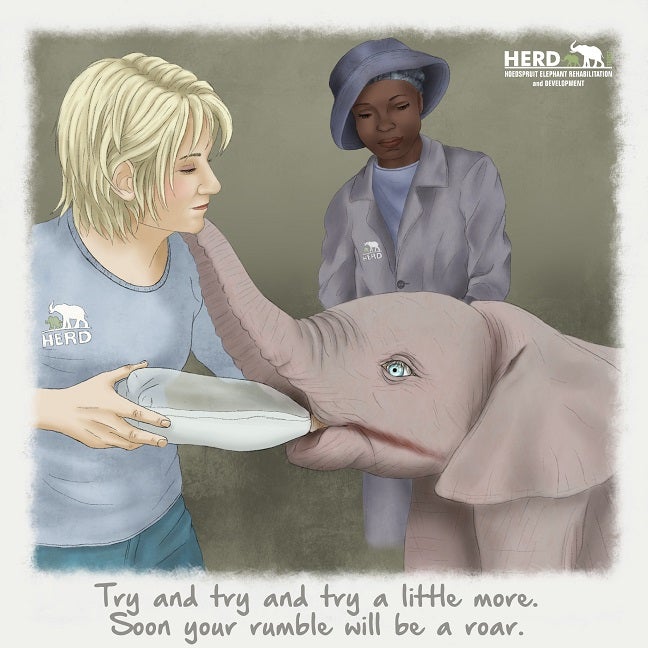
There was still a lot to overcome. Khanyisa wasn’t quite ready to receive all the help the team were giving her. She was still a wild young elephant, only four months of age and not familiar to the presence of humans. She was shaken, hungry, hurting and needed to slowly settle into her new environment. For now, she needed to sleep. Adine joined the little elephant inside, with Herman and Lammie. Lammie stood to the side, only metres from the pink calf, while Herman was seated alongside her and Adine. Adine stayed close to Khanyisa, trying to get her to lie down, to give in to her fatigue and rest her bones. She was safe now. She could start healing. And the first step in that path was sleep.
“Doodoo klein babatjie,” Adine sang quietly to the elephant, in a familiar lullaby that she had once sung to her own children when they were babies. “Doodoo klein babatjie,” meaning, “Sleep, little baby,” in Adine’s first language, Afrikaans. The repetitive words and rhythmic tone started to lull the standing calf and slowly but surely Khanyisa lowered her back legs and then her front legs onto the hay bed, and lay down, resting on the one side of her head. The hay caught in her wounds, the cuts across her cheeks, the top of her head and around her right ear. She slowly closed her eyes as her breathing grew heavy and into a soft snore as she inhaled and exhaled through her trunk. Adine pulled herself up closer to Khanyisa and rested a hand and her head on her rear, gently letting the elephant know she was there and continuing to comfort her as she fell into a much needed slumber.
“Elephant calves are just like human babies,” Adine said to Herman, but choosing the Afrikaans language that the two both shared in common. Every day, Adine would share more and more of her personal knowledge and experience of rehabilitating elephant orphans with Herman and other carers like him, so that the growing team could manage this very important job on their own. There was certainly no school for learning how to raise an orphaned elephant calf, but Adine had helped to look after many orphan elephants – as well as rhinos – over her years in conservation. Learning on the job, Herman had grown immensely in knowing just what a calf like Khanyisa needed.
“They need the warmth and love of a mother just like human infants. We are their mothers for now, until the other elephants take over this role. You can be her father though,” Adine smiled at Herman, who returned it with a laugh as he gazed over at the sleeping animal. Lammie let out a sudden baaa, making sure she was included in the conversation. “Yes, you’re a mommy too, ol’ Lam,” Adine replied.
The red heat lamps were switched on and shining down on the four seated on the hay. The nursery doors were closed and even Lammie was settling down – lying in the corner, with her woolly covering keeping her warm. It was January and summertime still, meaning a warmer evening in the wilderness. But keeping Khanyisa warm was vital so that she didn’t use her energy to generate body heat, but rather to feed her body and start gaining weight after her estimated four days alone in the bush before being rescued.
Tokwe had settled down too, and had joined the other elephants to eat the night’s fresh fare – lucerne and branches. The stars filled the sky now. Without the bright lights of buildings or city activity nearby, the stars were especially visible here in the reserve. Each cloudless night brought a show of shooting stars and those landmark constellations that let you guide yourself if you knew how to read them right. The orphanage team always believed that Lammie should have had her own constellation for all the guidance she had given orphan animals in need – with stars connecting an oval shape, four lines beneath, another oval above and one at the rear, for that distinctive tail. Perhaps if they wished hard enough, their eyes might just one day glimpse that very shape. If not in the stars, then at least in the clouds.
Adine gave Khanyisa a gentle rub, running her hand over the calf’s leg, and stood up. “I’ll go home now. Please keep me updated through the night, of her dung, her urine, her sleep,” Adine asked Herman, letting him take over night duty.
Herman had his own stretcher alongside the nursery to sleep in, peering at Khanyisa through the wooden poles that surrounded her section of the room. This way he could sleep if all was well, but wake easily if Khanyisa was up and needing anything – comforting, food, water. But that night, Herman stayed right beside Khanyisa on the hay, with Lammie close by. He wasn’t letting the new calf out of his sight for a moment.
- All images used here are from our Wisdoms Collection, available here >
- To adopt Khanyisa for her 4th birthday and help support her on her journey, kindly click here >

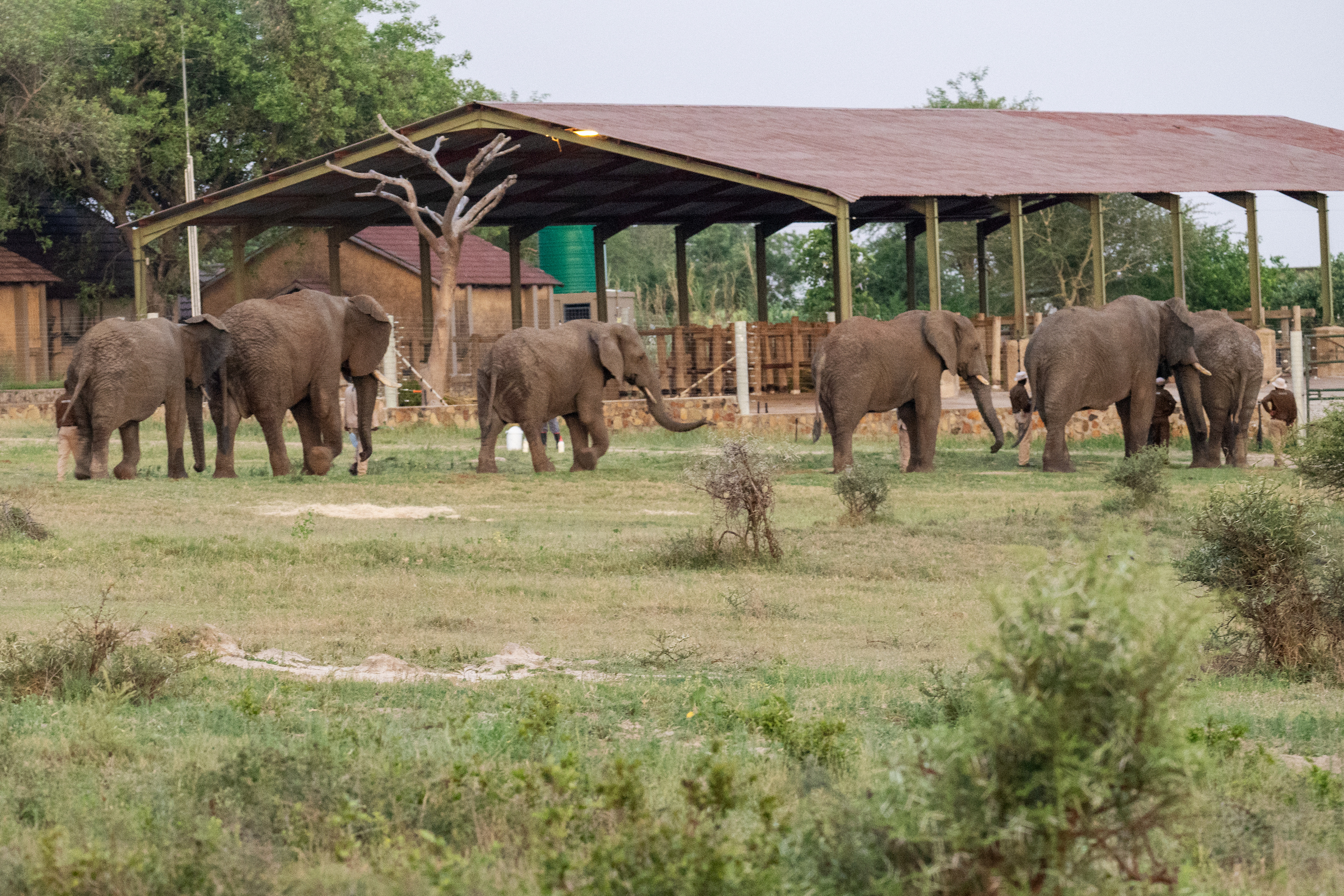

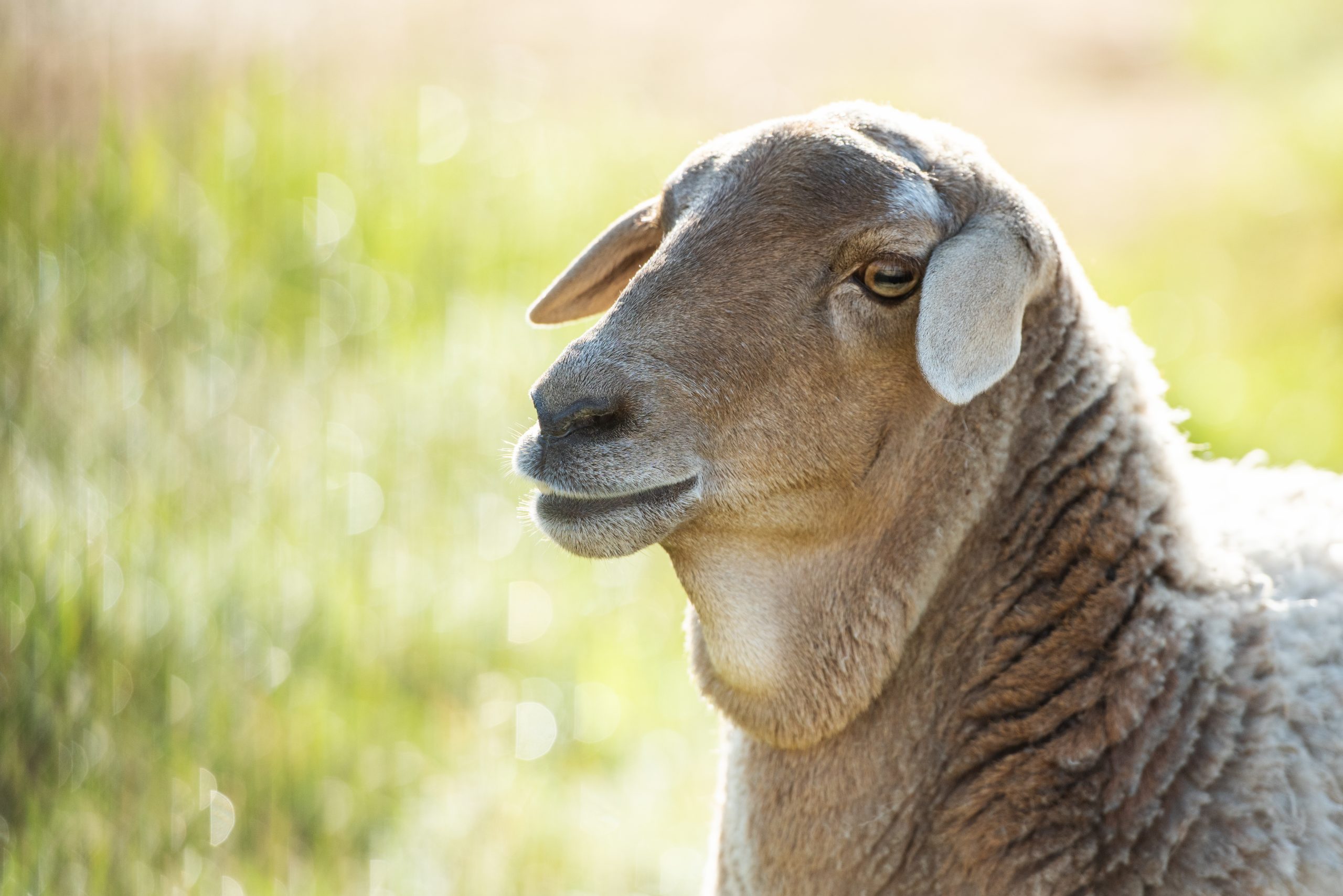

Wendy Jack
Khanyisa's book is beautifully written and illustrated. This first chapter follows her actual life so well. The illustrations are so realistic. It will be wonderful to see the entire book when it is completed. I wish every body the best of luck with developing it and getting it published.
Lynn Dixon
I discovered Kahnyasion YouTube a flew days ago and fell in love. She is so sweet and inspiring. Thank you HERD for sharing her story with us. This chapter was wonderful and I’m look forward to more.
Judy
A wonderful idea with a moral tale on how we look after our environment and the way we treat endangered creatures on whom we humans depend. The finest way is to teach from infancy so that young ones grow up into responsible adults who care about and love their environment, not just their communities.